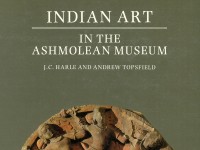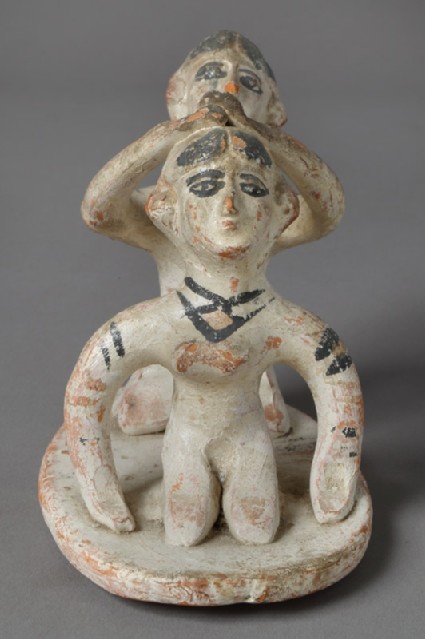Indian Art in the Ashmolean Museum
A catalogue of the Ashmolean’s collection of Indian art by J. C. Harle and Andrew Topsfield (published Oxford, 1987).

Publications online: 143 objects
Toy model of a woman having her hair dressed
-
Literature notes
The Museum has a number of figurines and toys in painted wood and terracotta from Bengal, Orissa, Rajasthan and other regions. Ephemeral by nature and therefore relatively recent in date, they nevertheless embody ancient traditions of modelling and decoration answering to the timeless needs and way of life of rural communities. Whether for use as temporary images in domestic religious rituals, as household utensils or as children’s playthings, they are produced with a lively dexterity and spontaneity of execution according to long established conventions.
This hair-dressing scene of two kneeling women with raised heads and curving, elongated arms is described as coming from Katalia, Murshidabad district. It is of a type popular in West Bengal, said by Mookerjee to be “commonly known as Birbhum toys because they are sold at the Paus-mela [fair] at Santiniketan”. The figures are freely modelled by hand but a mould has been used for the faces. A silvery-white mica coating is applied overall, finished with strokes of black colour defining the hair, eyes and jewellery. -
Details
- Associated place
-
Asia › India › east India › West Bengal › Murshidabad (Katalia) (place of creation)
- Date
- early 20th century
- Material and technique
- terracotta, hand-modelled and mould-made, and covered in mica, with painting in black
- Dimensions
- 11.5 x 9 x 15.7 cm (height x width x depth)
- Material index
- Technique index
- Object type index
- No. of items
- 1
- Accession no.
- EAX.2297
-
Further reading
Harle, J. C., and Andrew Topsfield, Indian Art in the Ashmolean Museum (Oxford: Ashmolean Museum, 1987), no. 76 on p. 68, illus. p. 68
Location
-
- currently in research collection
Objects are sometimes moved to a different location. Our object location data is usually updated on a monthly basis. Contact the Jameel Study Centre if you are planning to visit the museum to see a particular object on display, or would like to arrange an appointment to see an object in our reserve collections.
Publications online
-

Indian Art in the Ashmolean Museum
The Museum has a number of figurines and toys in painted wood and terracotta from Bengal, Orissa, Rajasthan and other regions. Ephemeral by nature and therefore relatively recent in date, they nevertheless embody ancient traditions of modelling and decoration answering to the timeless needs and way of life of rural communities. Whether for use as temporary images in domestic religious rituals, as household utensils or as children’s playthings, they are produced with a lively dexterity and spontaneity of execution according to long established conventions.
This hair-dressing scene of two kneeling women with raised heads and curving, elongated arms is described as coming from Katalia, Murshidabad district. It is of a type popular in West Bengal, said by Mookerjee to be “commonly known as Birbhum toys because they are sold at the Paus-mela [fair] at Santiniketan”. The figures are freely modelled by hand but a mould has been used for the faces. A silvery-white mica coating is applied overall, finished with strokes of black colour defining the hair, eyes and jewellery.
Notice
Object information may not accurately reflect the actual contents of the original publication, since our online objects contain current information held in our collections database. Click on 'buy this publication' to purchase printed versions of our online publications, where available, or contact the Jameel Study Centre to arrange access to books on our collections that are now out of print.
© 2013 University of Oxford - Ashmolean Museum

